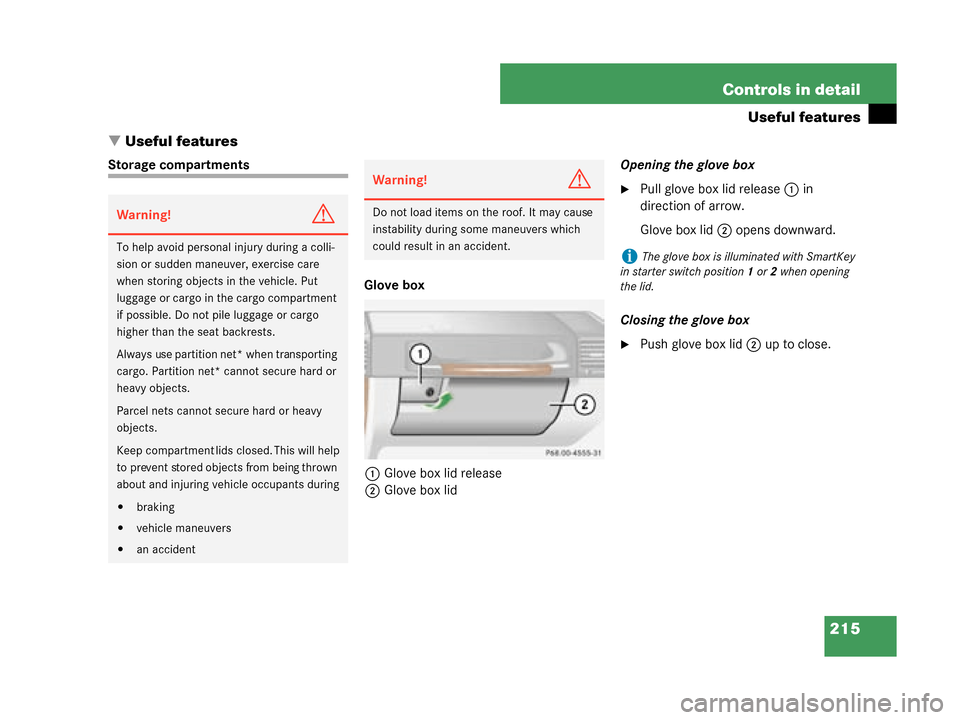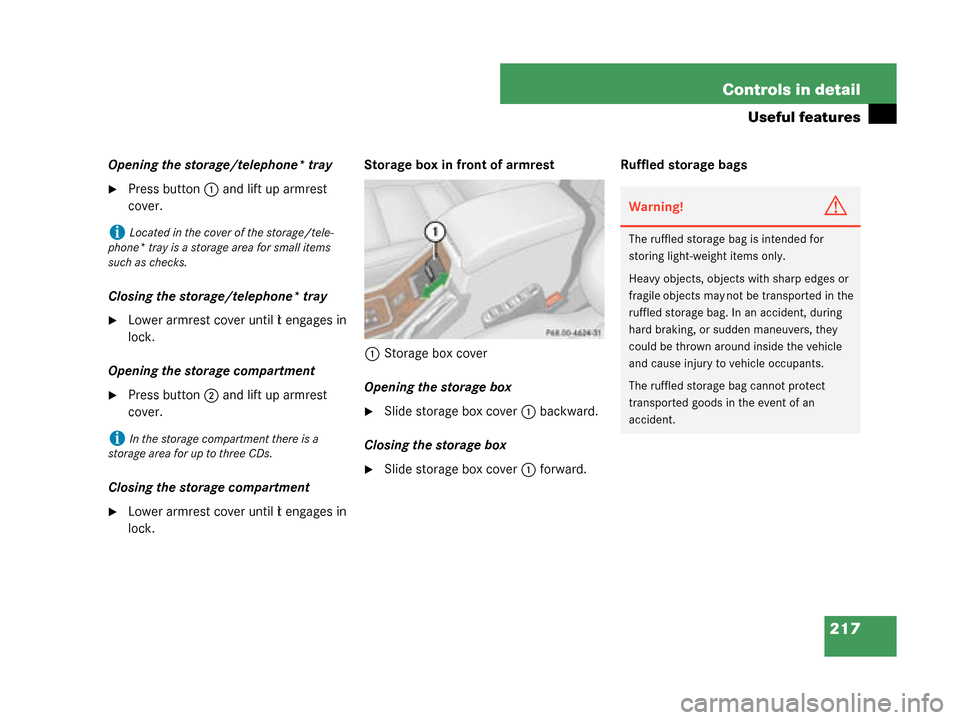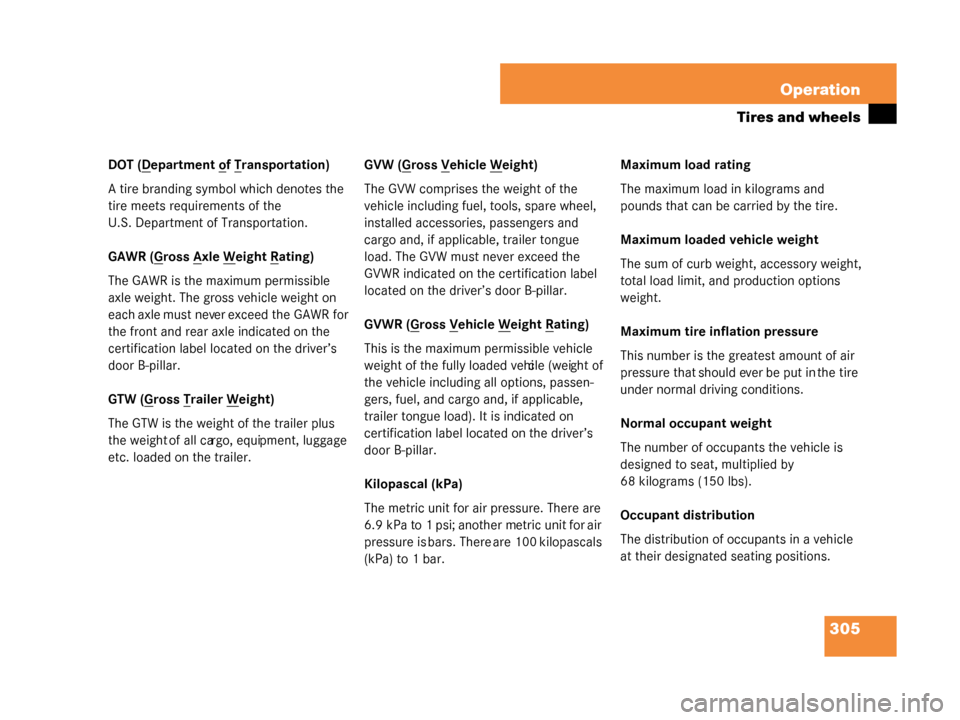Page 211 of 457
210 Controls in detail
Loading
Your vehicle is equipped with four cargo
tie-down rings located in the cargo com-
partment floor.1 Cargo tie-down rings Carefully secure cargo by applying even
load on all cargo tie-down rings with rope
of sufficient strength to hold down the
cargo.Partition net* (MB Accessory)
Warning!G
Make sure the partition net is properly
engaged at top and bottom position and the
tightening belts are securely fastened.
Never use a damaged partition net.
To help avoid personal
injury from smaller
objects being thrown around in the occu-
pant compartment during a collision or
sudden maneuver, always use partition net
when transporting cargo.
The partition net cannot prevent the move-
ment of large, heavier objects into the pas-
senger compartment in an accident. Such
items must be properly secured using the
cargo tie-down rings (
�page 209) in the
cargo compartment floor.
W463.boo Seite 210 Montag, 19 . November 2007 8:41 08
Page 212 of 457
211
Controls in detail
Loading
Use of the partition net is a particularly
important safety factor when the vehicle is
loaded higher than the top of the seat
backrests with smaller objects. For your
safety, always use the partition net when
transporting cargo.
The partition net can be installed behind
the seat backrests of the rear seat bench,
or behind the front seats if the rear seat
bench is folded forward.
Installing partition
net behind rear seat
bench
Partition net installed behind rear seat
bench
�Fold the rear seat bench forward
(
�page 207). Hanging up partition net
1 Partition net
2 Holder
�Hang partition net 1 on holder 2 and
push forward in direction of the arrow.
iInstallation can be performed by opening
the rear doors.
iThis cannot be done by folding the rear seat
backrest forward.
W463.boo Seite 211 Montag, 19 . November 2007 8:41 08
Page 216 of 457

215
Controls in detail
Useful features
� Useful features
Storage compartments
Glove box
1 Glove box lid release
2 Glove box lid Opening the glove box
�Pull glove box lid release
1 in
direction of arrow.
Glove box lid 2 opens downward.
Closing the glove box
�Push glove box lid 2 up to close.
Warning!G
To help avoid personal injury during a colli-
sion or sudden maneuver, exercise care
when storing objects in the vehicle. Put
luggage or cargo in the cargo compartment
if possible. Do not pile luggage or cargo
higher than the seat backrests.
Always use partition net* when transporting
cargo. Partition net* cannot secure hard or
heavy objects.
Parcel nets cannot secure hard or heavy
objects.
Keep compartment lids closed. This will help
to prevent stored objects from being thrown
about and injuring vehicle occupants during
�braking
�vehicle maneuvers
�an accident
Warning!G
Do not load items on the roof. It may cause
instability during some maneuvers which
could result in an accident.
iThe glove box is illuminated with SmartKey
in starter switch position 1 or2 when opening
the lid.
W463.boo Seite 215 Montag, 19 . November 2007 8:41 08
Page 218 of 457

217
Controls in detail
Useful features
Opening the storage/telephone* tray
�Press button
1 and lift up armrest
cover.
Closing the storage/telephone* tray
�Lower armrest cover until it engages in
lock.
Opening the storage compartment
�Press button 2 and lift up armrest
cover.
Closing the storage compartment
�Lower armrest cover until it engages in
lock. Storage box in front of armrest
1 Storage box cover
Opening the storage box
�Slide storage box cover 1 backward.
Closing the storage box
�Slide storage box cover 1 forward. Ruffled storage bags
iLocated in the cover of the storage/tele-
phone* tray is a storage area for small items
such as checks.
iIn the storage compartment there is a
storage area for up to three CDs.
Warning!G
The ruffled storage bag is intended for
storing light-weight items only.
Heavy objects, objects with sharp edges or
fragile objects may not be transported in the
ruffled storage bag. In an accident, during
hard braking, or sudden maneuvers, they
could be thrown around inside the vehicle
and cause injury to vehicle occupants.
The ruffled storage bag cannot protect
transported goods in the event of an
accident.
W463.boo Seite 217 Montag, 19 . November 2007 8:41 08
Page 219 of 457
218 Controls in detail
Useful features
Ruffled storage bags are located on the
front seat backrests.1 Ruffled storage bag Parcel net in front passenger footwell
A small convenience parcel net is located
in the front passenger footwell. It is for
small and light items, such as road maps,
mail, etc.
1 Parcel net
Warning!G
The parcel net is intended for storing
light-weight items only.
Heavy objects, objects with sharp edges or
fragile objects may not be transported in the
parcel net. In an accident, during hard
braking, or sudden ma neuvers, they could
be thrown around inside the vehicle and
cause injury to vehicle occupants.
The parcel net cannot protect transported
goods in the event of an accident.
!When large objects are stored in the parcel
net, do not slide the seat fully forward, it could
damage them.
W463.boo Seite 218 Montag, 19 . November 2007 8:41 08
Page 253 of 457

252 Operation
Driving instructions
Standing water
To prevent water from entering the
passenger compartment or the engine
compartment if you must drive through
standing water, keep in mind
�the maximum depth of the water may
not exceed 19 in (48 cm)
�you must drive slowlyFor more information, see “Driving through
water” (
�page 257).
Passenger compartment
!Do not drive through flooded areas or water
of unknown depth. Before driving through water,
determine its depth. Never accelerate before
driving into water. The bow wave could force
water into the engine and auxiliary equipment,
thus damaging them.
If you must drive through standing water, drive
slowly to prevent water from entering the
passenger compartment or the engine
compartment. Water in these areas could cause
�damage to electrical components
�wiring of the engine or transmission
or could result
�in water being ingested by the engine
through the air intake, causing severe
internal engine damage.
Any such damage is not covered by the
Mercedes-Benz Limited Warranty.
Warning!G
Always fasten items being carried as
securely as possible.
In an accident, during hard braking or sud-
den maneuvers, loose items will be thrown
around inside the vehi cle, and cause injury
to vehicle occupants unless the items are
securely fastened in the vehicle.
The rear cargo compartm ent is the preferred
place to carry objects. Always use cargo
tie-down rings, and if so equipped, always
use partition net* when transporting cargo.
The partition net* cannot secure hard or
heavy objects. Always fasten items being
carried as securely as possible using the
cargo tie-down rings in the cargo compart-
ment floor and fastening materials.
Do not load items on the roof. It may cause
instability during so me maneuvers which
could result in an acci dent. This vehicle is
not intended to carry items on its roof. Thus
roof rails and roof mounted ski or bike
holders must not be used.
W463.boo Seite 252 Montag, 19 . November 2007 8:41 08
Page 301 of 457

300 Operation
Tires and wheels
DOT (Department of Transportation)
A tire branding symbol 1 (
�page 299)
which denotes the tire meets require-
ments of the U.S. Department of
Transportation.
Manufacturer’s id entification mark
The manufacturer’s identification mark2
(
�page 299) denotes the tire
manufacturer.
New tires have a mark with two symbols.
Retreaded tires have a mark with four sym-
bols. For more information on retreaded
tires (
�page 277).
Tire size
The code 3 (
�page 299) indicates the
tire size. Tire type code
The code
4 (
�page 299) may, at the
option of the manufacturer, be used as a
descriptive code for identifying significant
characteristics of the tire.
Date of manufacture
The date of manufacture 5 (
�page 299)
identifies the week and year of manufac-
ture.
The first two figures identify the week,
starting with “01” to represent the first full
week of the calendar year. The second two
figures represent the year.
For example, “3202” represents the 32nd
week of 2002.
Maximum tire load
1 Maximum tire load rating
The maximum tire load is the maximum
weight the tires are designed to support.
iFor illustration purposes only. Actual data
on tires are specific to each vehicle and may vary
from data shown in above illustration.
W463.boo Seite 300 Montag, 19 . November 2007 8:41 08
Page 306 of 457

305
Operation
Tires and wheels
DOT (Department of Transportation)
A tire branding symbol which denotes the
tire meets requirements of the
U.S. Department of Transportation.
GAWR (G
ross Axle Weight Rating)
The GAWR is the maximum permissible
axle weight. The gross vehicle weight on
each axle must never exceed the GAWR for
the front and rear axle indicated on the
certification label located on the driver’s
door B-pillar.
GTW (G
ross Trailer Weight)
The GTW is the weight of the trailer plus
the weight of all ca rgo, equipment, luggage
etc. loaded on the trailer. GVW (G
ross Vehicle Weight)
The GVW comprises the weight of the
vehicle including fuel, tools, spare wheel,
installed accessories, passengers and
cargo and, if applic able, trailer tongue
load. The GVW must never exceed the
GVWR indicated on the certification label
located on the driver’s door B-pillar.
GVWR (G
ross Vehicle Weight Rating)
This is the maximum permissible vehicle
weight of the fully loaded vehicle (weight of
the vehicle including all options, passen-
gers, fuel, and cargo and, if applicable,
trailer tongue load). It is indicated on
certification label located on the driver’s
door B-pillar.
Kilopascal (kPa)
The metric unit for air pressure. There are
6.9 kPa to 1 psi; another metric unit for air
pressure is bars. There are 100 kilopascals
(kPa) to 1 bar. Maximum load rating
The maximum load in kilograms and
pounds that can be carried by the tire.
Maximum loaded vehicle weight
The sum of curb weight, accessory weight,
total load limit, and production options
weight.
Maximum tire inflation pressure
This number is the greatest amount of air
pressure that should ever be put in the tire
under normal driving conditions.
Normal occupant weight
The number of occupants the vehicle is
designed to seat, multiplied by
68 kilograms (150 lbs).
Occupant distribution
The distribution of occupants in a vehicle
at their designated seating positions.
W463.boo Seite 305 Montag, 19
. November 2007 8:41 08